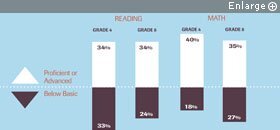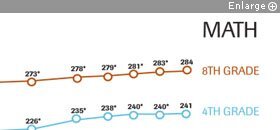The nation’s 4th and 8th graders have inched up in mathematics, new test data show, but the results are more mixed in reading, with 4th grade scores flat compared with two years ago.
Overall, achieving proficiency in reading and math on the National Assessment of Educational Progress, known as “the nation’s report card,” remains an elusive goal for the majority of American students. Only about one-third reached that level or higher in reading and 8th grade math, the 2011 data show. At grade 4 math, the figure was slightly higher, at 40 percent.
When viewed from a long-term perspective, the nation has made “major improvements” in math achievement over the past two decades, but in reading, the growth has been “quite small,” David P. Driscoll, the chairman of the National Assessment Governing Board, which sets policy for NAEP, said at an event last week announcing the results.
Doris R. Hicks, also a member of to make gains on NAEP in both math and reading in most years.”
NAGB and the principal of a New Orleans charter school, lamented that 4th grade reading scores have not improved since 2007.
Based on the latest results from the National Assessment of Educational Progress, a majority of American students still are not “proficient” in reading and math.

SOURCE: National Center for Educational Statistics
“That rang an alarm bell with me,” she said at the event. “Even though it wasn’t a decline, I saw it as losing ground.”
Since 1992, the average scale score in 4th grade reading has climbed just 4 points, to 221, on a 0-to-500 scale. At the 8th grade, the average score has risen 5 points.
By contrast, in math, 4th grade scores have climbed 21 points over the same period, and 8th grade scores have increased by 16 points. In fact, the long-term growth is even stronger when looking back to 1990, when the math exam was first given. (The reading test began in 1992.)
More recently, from 2009 to 2011, the math figures at both grade levels climbed 1 point, as did 8th grade reading scores.
At the same time, Mr. Driscoll, a former education commissioner in Massachusetts, expressed concern that math improvement is not keeping pace with earlier gains.
to make gains on NAEP in both math and reading in most years.”
“Over the past eight years, progress has slowed, particularly at grade 4 where it had been very rapid for more than a decade,” he said. “The percentage of students ‘below basic’ has been reduced substantially, but it still remains far too high—particularly at 8th grade for blacks and Hispanics.”
U.S. Secretary of Education Arne Duncan voiced some disappointment with the latest results.
“The modest increases in NAEP scores are reason for concern as much as optimism,” he said in a statement. “It’s clear that achievement is not accelerating fast enough for our nation’s children to compete in the knowledge economy of the 21st century.
Stubborn Gaps
The reading and math NAEP is administered every two years to 4th and 8th graders. In math, it tests students in five content areas: number properties and operations; measurement; geometry; data analysis, statistics, and probability; and algebra. The reading assessment targets three domains: locating and recalling information students have read, integrating and interpreting that material, and critiquing and evaluating it.
Over the past two decades, growth in math achievement on NAEP has far eclipsed that in reading.

SOURCE: National Center for Education Statistics
One area of long-standing concern is the large achievement gaps among racial and ethnic groups, especially when comparing African-American and Hispanic students with white students. Although all groups have made progress over the past two decades, the achievement gaps have proven difficult to close.
The 2011 reading and math results produced no statistically significant changes in the black-white achievement gap from 2009. In fact, the 2011 gap of 31 points was not deemed statistically different from 1990. That said, the black-white gap has declined somewhat in other categories since 1990, including by 7 points for 4th grade math.
The gap between Hispanic and white students declined slightly between 2009 and 2011 in two categories. In 8th grade reading, the gap was reduced by 2 points, to 22. In 8th grade math, the gap was reduced by 3 points, to 23. But the 2011 figure was about the same as the gap recorded back in 1990.
To be sure, both Hispanic and black students have posted considerable academic gains over time, with especially strong strides in math.
In 1990, 83 percent of black 4th graders scored below basic in the subject. By 2011, that figure had plummeted to 34 percent. (The change since 2009 was not statistically significant.) Likewise, far fewer Hispanic 4th graders are performing below basic today, with the percentage declining from 67 percent in 1990 to 28 percent now.
The changes in 8th grade math for African-American and Hispanic students have also been large, though not quite as dramatic. For blacks, the below-basic figure has declined from 78 percent in 1990 to 49 percent today. For Hispanics, it has dropped from 66 percent to 39 percent. (Unlike with black 8th graders, the change between 2009 and 2011 was statistically significant for Hispanics, dropping from 43 percent to 39 percent.)
State Ups and Downs
The new NAEP results also highlight changes in state by state performance. Hawaii was the only state to see improvements in both subjects at both grade levels. Maryland’s reading scores improved at both the 4th and 8th grades. In addition, the District of Columbia, New Mexico, and Rhode Island saw improved math scores at both grade levels.
On the flip side, 4th grade math achievement declined in New York, and Missouri’s 8th graders fell in math. In reading, Missouri and South Dakota saw declines.
Over the past eight years, during which all states have been required to participate in the NAEP in reading and math, the largest overall gains occurred in Maryland, Massachusetts, and the District of Columbia, when looking at the increase in the percent reaching “proficient” in both subjects, Mr. Driscoll said. And yet several other states “stood virtually still,” including Iowa, New York, and West Virginia.
“The NAEP results for New York students are disappointing and unacceptable,” John B. King Jr., that state’s education commissioner, said in a statement. “New York needs change.” He noted that the state recently adopted a “comprehensive reform agenda,” including the new common standards, with the goal of ensuring all students are prepared for college and a career.
Nevada registered statistically significant gains of 4 points in both 8th grade reading and math compared with 2009. The state also saw 2-point gains in 4th grade reading and math, but neither was statistically significant.
Keith W. Rheault, Nevada’s superintendent of public instruction, who joined last week’s event announcing the NAEP results, said he was pleased to see his state’s gains, especially amid tough economic times.
"[D]uring the current recession, Nevada has become number one in the nation in some pretty dismal statistics,” including foreclosures, unemployment, and bankruptcy rates, he said. “Property-tax collections are down, the state budget has been cut, the teaching force has been reduced, and spending on K-12 education has been cut by several hundred million dollars since 2008. However, in spite of all these problems, our state has continued to make gains on NAEP in both math and reading in most years.”




